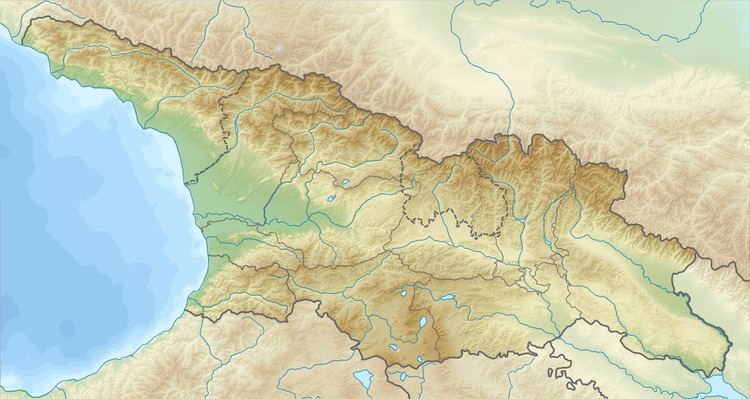Altitude 360 m (1,181 ft) Length 125 m | Type karst cave | |
 | ||
Region Sataplia-Tskaltubo karst massif Excavation dates 1976, 1985–88, 1989–1992, 2008–2010, 2012–2013 | ||
Satsurblia Cave is a paleoanthropological site located near Kumistavi village, Tskaltubo district, in the Imereti region of Georgia. The karst cave was first excavated in 1976 by A. N. Kalandadze.
Contents
Archaeology
Prehistoric people first occupied the cave from around 25,500 to 24,400 BP. The next period of human occupation at Satsurblia took place from around 17,000 to 16,200 BP. The hiatus in human occupation at Satsurblia coincides with the Last Glacial Maximum.
Lithic artefacts, bone artefacts, charcoal, flax fibers, and pottery were discovered at the cave. The lithic artefacts show similarities to eastern Epi-Gravettian sites. Perforated pendants made out of stalagmite and polished bovid bone were also discovered. The remains of yellow, red and brown ochre were also found at the site.
Unlike most other Paleolithic sites found in Georgia that relied primarily on hunting one species, the people of Satsurblia appeared to have hunted a slightly more diverse range of species. The animal remains found at Satsurblia were dominated primarily by wild boar, followed by red deer; the remains of aurochs, steppe bison, Capra caucasica, and roe deer were also found. Some brown bear, wolf, fox, and Eurasian beaver remains were also found at the site.
Genetics
In 2013, archaeologists found a temporal bone fragment of an ancient human in the cave. Direct AMS dating of the bone yielded an estimated date of 13,300 BP for the age of the bone. Researchers successfully extracted DNA from the petrous part of the temporal bone and managed to recover low coverage genomes.
The ancient individual from Satsurblia was male with black hair and brown eyes; however, the individual is one of the earliest found to carry the derived HERC2 allele for blue eyes. The Satsurblia individual also likely had light skin, as he was found to carry the derived SLC24A5 allele for light skin. The Satsurblia individual was also lactose intolerant and did not carry the derived EDAR allele commonly found in East Asians and Native Americans.
The Satsurblia individual belongs to mtDNA Haplogroup K3 and Y-DNA Haplogroup J. About 1.7-2.4% of the Satsurblia individual's DNA was Neanderthal in origin.
Caucasus hunter-gatherers
The Satsurblia individual is genetically closest to an ancient individual, dating to around 9,700 BP, found at the Kotias Klde rock shelter in Georgia. Together, they form a genetically distinct cluster that is often referred to as Caucasus hunter-gatherers.
The Caucasus hunter-gatherers descended from a population that split off very early around 45,000 years ago, pre-dating the split that led to differentiated populations that descended separately to Ust'-Ishim man, Oase1 and European hunter-gatherers. The Caucasus hunter-gatherers managed to survive in isolation through the last Ice Age as a distinct population.
Relationship to modern populations
In comparison to modern human populations, the Satsurblia individual is closest to modern populations from the South Caucasus.
The Caucasus hunter-gatherers contributed significantly to modern European populations by way of the Yamna people. Around half of the Yamna people's DNA come from the Caucasus hunter-gatherers. The Caucasus hunter-gatherers also contributed genetically to modern Central Asians and South Asians.
